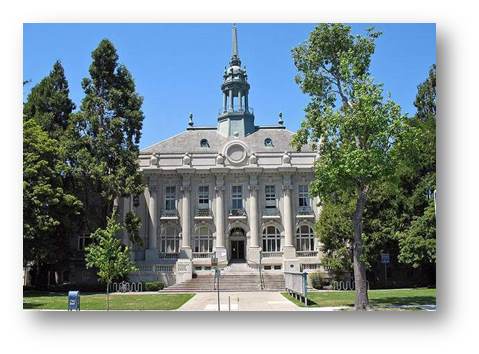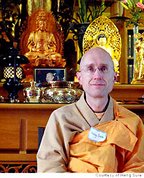Our first walk took place in 2001, less than a year after MSHHIG was founded. It was 1 of 10 “Carefree/Carfree Tours” that formed part of the 2001 Berkeley Arts Festival, a citywide event that ran from June 16 through June 30. The tours wee “carefree” because they were free of charge and no reservations were needed.
 We wondered if
anyone would come, since the only advertising our tour had received was a brief
listing in the festival’s official program. But we needn’t have worried. At
3:00 PM on June 30 some one dozen hardy souls assembled on the steps of Old
City Hall. Furnished with a 12-page handout, they followed a circuitous route
that took in the City Hall Annex, the church of
St. Joseph the Worker, the original Sandwich City, the Berkeley Buddhist
Monastery, and what to many was a surprising number of interesting old houses.
Our showpiece was 2418 California Street, which we had recently caused to be
landmarked as the Hunter House. All this was probably too much for a “carefree”
tour. It was a hot day, and only about a third of the original dozen made it
back to Old City Hall.
We wondered if
anyone would come, since the only advertising our tour had received was a brief
listing in the festival’s official program. But we needn’t have worried. At
3:00 PM on June 30 some one dozen hardy souls assembled on the steps of Old
City Hall. Furnished with a 12-page handout, they followed a circuitous route
that took in the City Hall Annex, the church of
St. Joseph the Worker, the original Sandwich City, the Berkeley Buddhist
Monastery, and what to many was a surprising number of interesting old houses.
Our showpiece was 2418 California Street, which we had recently caused to be
landmarked as the Hunter House. All this was probably too much for a “carefree”
tour. It was a hot day, and only about a third of the original dozen made it
back to Old City Hall.
This experience
taught us several lessons. First, people were interested; several,  in
fact, had joined us along the way, asking questions that we were unable to
answer but also providing useful information. Second, people needed to be given
more subjects to be interested in; architectural information, for instance,
could easily become excessive. Third, if some of the institutions on our route
would be kind enough to participate, they could serve as convenient assembly or
stopping points (and might even have bathroom facilities). Fourth, sponsorship
by an established Berkeley institution, with the help of an experienced walk
leader, would surely help us attract more people.
in
fact, had joined us along the way, asking questions that we were unable to
answer but also providing useful information. Second, people needed to be given
more subjects to be interested in; architectural information, for instance,
could easily become excessive. Third, if some of the institutions on our route
would be kind enough to participate, they could serve as convenient assembly or
stopping points (and might even have bathroom facilities). Fourth, sponsorship
by an established Berkeley institution, with the help of an experienced walk
leader, would surely help us attract more people.
Miraculously, the last condition was soon fulfilled by the adherence of Paul Grunland, a longtime organizer of historical walks and a pillar of the BHS. So it was under BHS auspices, and with Paul’s advice and leadership that, on September 14, 2003, we held our second walking tour. Several weeks of preparation went into this effort. Paul and a member of MSHHIG walked the proposed route in advance and changed it to fit the advertised two-hour limit. Our handout, which ran to 44 typed pages, contained both historical and ecological data; in addition to a running commentary on the built environment; there were also some photocopied illustrations. We felt that even though people would probably not absorb all this information in two hours, they could refer to it later, while our tour guides could save time and breath by suggesting that they do so.
 Finally -- our
best move, as it turned out -- we contacted both St. Joseph’s and the Berkeley
Buddhist Monastery, to see if they would admit us. They would, and we were
graciously received at both places. The
walk, beginning at St. Joseph’s, where the Reverend George Crespin showed us round the beautiful interior, was
advertised as the first in the BHS’s fall 2002
series of walking tours and attracted well over the BHS’s usual
20-person limit, many joining us along the way and, as before, volunteering
information. Nobody got lost -- we had supplied route maps -- and we offered
lemonade and cookies afterwards, in Presentation Minipark. Of course, it all lasted more than
two hours.
Finally -- our
best move, as it turned out -- we contacted both St. Joseph’s and the Berkeley
Buddhist Monastery, to see if they would admit us. They would, and we were
graciously received at both places. The
walk, beginning at St. Joseph’s, where the Reverend George Crespin showed us round the beautiful interior, was
advertised as the first in the BHS’s fall 2002
series of walking tours and attracted well over the BHS’s usual
20-person limit, many joining us along the way and, as before, volunteering
information. Nobody got lost -- we had supplied route maps -- and we offered
lemonade and cookies afterwards, in Presentation Minipark. Of course, it all lasted more than
two hours.
Most of the architectural information in these two early walk handouts was based on our 2001 Built Environment Survey. Although the survey is in some respects outdated, we have reproduced extracts from both handouts here, since much of this information is not readily available.